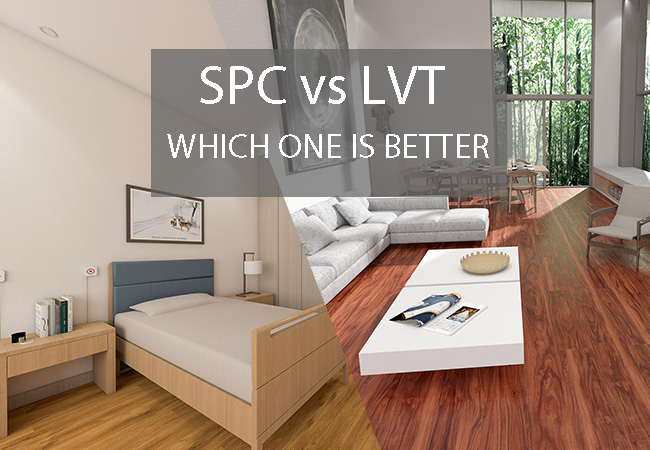SPC Flooring vs LVT Flooring: Difference and Comparison
SPC (Stone Plastic Composite) flooring and LVT (Luxury Vinyl Tile) flooring are both popular choices in the world of vinyl flooring, but they have distinct differences in their composition, structure, and performance. Here's a detailed comparison of the two:

1. Core Composition:
SPC Flooring: Rigid Core: SPC flooring has a core made of a mixture of limestone powder, polyvinyl chloride (PVC), and stabilizers. This creates a very dense, rigid core that makes SPC flooring more stable and durable. Stone-Based: The stone-based core gives SPC flooring its signature rigidity, making it less prone to expansion and contraction due to temperature changes.
LVT Flooring: Flexible Core: LVT flooring has a softer, more flexible core made primarily of PVC and other vinyl materials. It does not contain stone powder, making it more pliable. Vinyl-Based: The flexibility of LVT allows it to mimic the look of natural materials more closely, especially in terms of texture and feel.
2. Thickness and Durability:
SPC Flooring: Thickness: Typically ranges from 3.2mm to 7mm. Durability: SPC Flooring is more resistant to impacts and can handle heavy foot traffic and furniture better due to its rigid core. It's less likely to dent or show wear over time.
LVT Flooring: Thickness: Typically ranges from 2mm to 5mm. Durability: LVT is durable but more prone to denting compared to SPC, especially under heavy furniture. However, it still offers good wear resistance due to its wear layer.
3. Installation:
SPC Flooring: Click-Lock System: Most SPC floors use a click-lock system, making them easy to install as floating floors without the need for glue or nails. Subfloor Flexibility: SPC can be installed over uneven subfloors with fewer concerns about telegraphing imperfections, thanks to its rigid core.
LVT Flooring: Glue-Down or Click-Lock: LVT can be installed using a glue-down method or a click-lock system, depending on the product. Subfloor Preparation: LVT generally requires a more level subfloor because its flexible nature can reveal imperfections more easily.
4. Water Resistance:
SPC Flooring Waterproof: SPC is 100% waterproof, making it ideal for areas prone to moisture, such as bathrooms, kitchens, and basements.
LVT Flooring Water-Resistant: LVT is also highly water-resistant, but not as impermeable as SPC. It can handle spills and moisture but may not perform as well as SPC in areas with consistent exposure to water.
5. Comfort and Sound:
SPC Flooring: Underfoot Comfort: Due to its rigid core, SPC flooring can feel harder underfoot compared to LVT. Sound: SPC flooring tends to transmit more sound, although underlayment can help reduce noise levels.
LVT Flooring: Underfoot Comfort: LVT is softer and warmer underfoot, making it more comfortable to walk on. Sound: LVT generally has better sound absorption due to its flexibility, making it quieter to walk on.
6. Appearance and Aesthetics:
SPC Flooring Visuals: While SPC flooring offers a wide range of designs, including realistic wood and stone looks, the rigid core can sometimes limit the depth and texture of the visuals compared to LVT.
LVT Flooring Visuals: LVT is known for its superior visual appeal, offering highly realistic textures and designs that closely mimic natural materials like wood and stone. The softer core allows for more detailed embossing.
7. Cost:
SPC Flooring Price Range: Generally, SPC flooring can be slightly more expensive than LVT due to its enhanced durability and rigidity.
LVT Flooring Price Range: LVT is often more affordable, especially in the standard or glue-down versions.
SPC Flooring is ideal for areas where durability, water resistance, and installation ease are critical. It's well-suited for commercial spaces, high-traffic areas, and rooms with moisture exposure. LVT Flooring is better for spaces where comfort, sound absorption, and highly realistic aesthetics are priorities. It works well in residential settings where comfort underfoot is valued.


 皖公网安备 34180202000049号
皖公网安备 34180202000049号